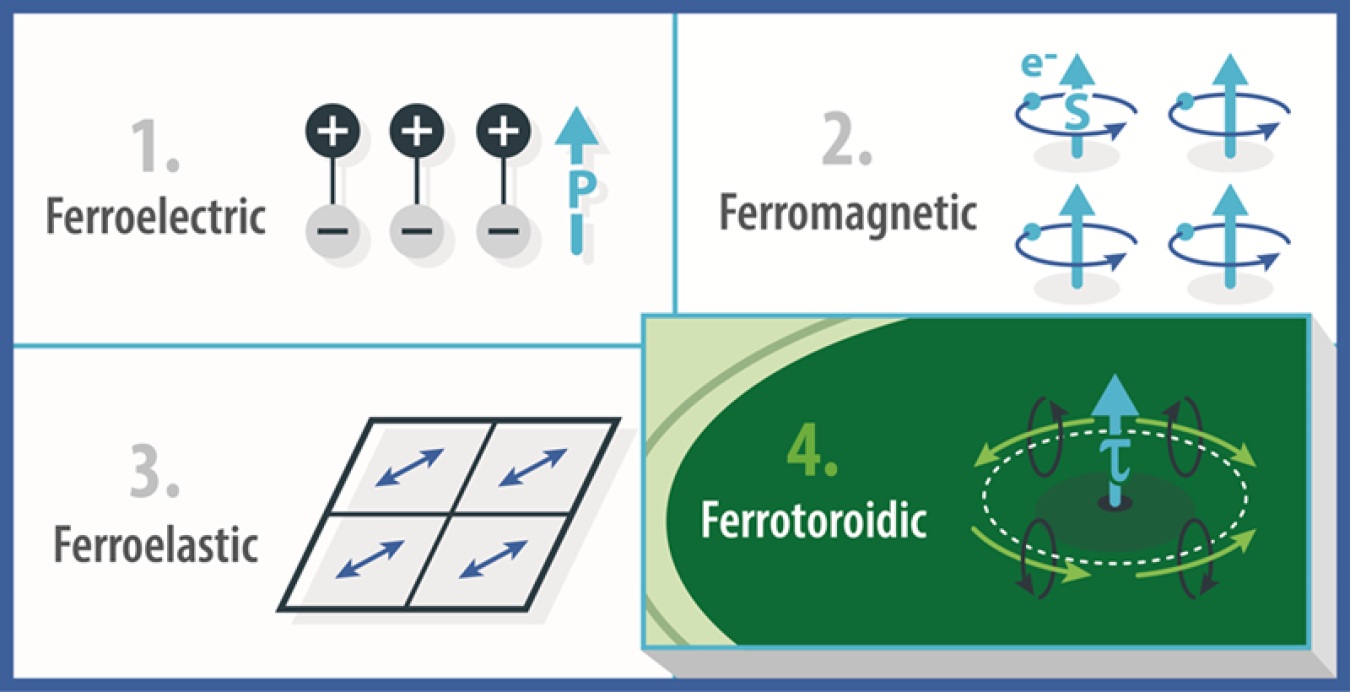Mapping a way to ferrotoroidicity: the long-sought fourth ferroic order with magnetic-electric properties that can enable new technologies.
June 23, 2025The Science
Olivines are common minerals that have magnetic and electrical properties useful for many applications. For example, olivines can be durable cathodes that improve the safety of lithium-ion batteries. However, these materials are magnetic only at very low temperatures (below -200° Fahrenheit). This makes it hard to use them in common applications. Scientists have found a way to tune the magnetic properties and raise the magnetic transition temperature of olivine phosphate. The solution is to remove some of the material’s lithium. Neutron studies reveal that the mineral’s chemistry begins to transition to magnetic at higher temperatures as the amount of lithium decreases. This discovery in olivines might be evidence of the long-sought fourth ferroic order, ferrotoroidicity.
The Impact
Ferroics in physics involves materials that have properties that change under certain conditions. For example, ferromagnetic materials become magnetic when exposed to an external magnetic field. Multiferroics are materials with coupled magnetic and electrical properties that exhibit spontaneous positive/negative polarity. They offer an efficient way to control magnetism by using electric fields or to control electrical polarization by using magnetic fields. Ferroic materials have previously enabled important technologies. These include permanent magnets, capacitors, and shape-memory materials such as cardiovascular stents. Ferrotoroidicity is a theorized form of ferroics. It involves materials whose magnetic domains are switched when exposed to external magnetic fields. Magnetic domains are parts of a material where the atoms’ magnetic fields are aligned and grouped together. Researchers believe that ferrotoroidicity features magnetic vortices, or magnetic whirlpools. The direction that these vortices rotate could likely be changed using electrical fields. This could lead to a new way to store and retrieve electronic data. A clockwise rotation could represent the binary number “0” and a counterclockwise rotation could represent a binary “1.”
Summary
Ferroic orders have been highly useful for enabling important technologies: ferromagnetism led to permanent magnets, ferroelectricity led to capacitors and piezoelectrics, and ferroelasticity led to shape-memory materials such as cardiovascular stents. Discovering a new, fourth ferroic order – ferrotoroidicity – would also have significant technological implications. This new ferroic order has remained elusive, with ambiguous evidence obtained only from materials seen as long-shots for such properties. In theory, scientists believe ferrotoroidicity involves magnetic vortices, or magnetic whirlpools, that could facilitate faster data storage and retrieval.
This study attempted to identify ferrotoroidicity through careful analysis and novel preparation techniques of olivine phosphates (LiFeMnPO4), a newly identified family of potentially ferrotoroidal compounds. Neutron diffraction characterized the structures and magnetic properties of the olivine materials, which contained various amounts of lithium. Historically, the olivines only exhibited the desired magnetic transition at low temperatures (below -200 degrees Fahrenheit), limiting their usefulness in technological applications. The scientists found that reducing the lithium content in the olivine phosphate could raise the magnetic transition temperature while maintaining the conditions necessary to allow a ferrotoroidal order to form. The study is helping to develop the ferrotoroidicity field by producing a road map toward accessing similar properties in other materials.
Contact
Efrain E. Rodriguez
University of Maryland
efrain@umd.edu
Keith M. Taddei
Oak Ridge National Laboratory
taddeikm@ornl.gov
Funding
This work was supported by the Department of Energy (DOE) Office of Science, Office of Basic Energy Sciences and the X-ray Crystallographic Center and the Quantum Materials Center at the University of Maryland. A portion of this research used resources at the High Flux Isotope Reactor, a DOE Office of Science user facility.
Publications
Diethrich, T.J., et al., Tuning Magnetic Symmetry and Properties in the Olivine Series Li1−xFexMn1−xPO4 through Selective Delithiation. Chemistry of Materials 34, 5039−5053 (2022). [DOI: 10.1021/acs.chemmater.2c00372]


